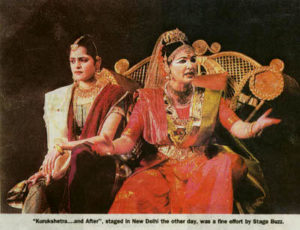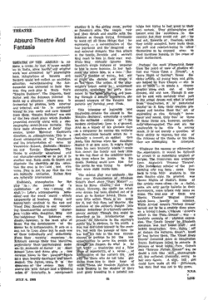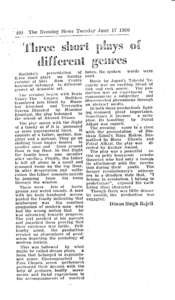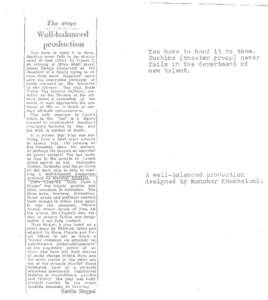Singh is King – A review by Manohar Khushalani
No Jokinnng!
Singh is Singinng All The Way to The Bank!!
A review by Manohar Khushalani
(L)Kinng tomfolling with the Mummies in Egypt (R) Katrina Kaif sizzling in Kinng
Don’t be fooled by the voices of protest from some of the elders of the Sikh community. If reactions of the younger audiences (even amongst the Sikhs) is anything to go by the Kids seem to love it. On the first day of the show the hall was packed with Sikhs. Initially the elders were trying to suppress their reactions because they did not know whether they should enjoy the film or look at it disapprovingly. But when they saw the young ones jumping like jelly beans in their seats they soon joined in. Yes the film has points of discomfort for the conservative lot but the intent of the producers does not appear to be vicious and therefore they ultimately tend to look the other way.
Akshay Kumar and Katrina Kaif starrer Singh is Kinng had a record opening in theatres across the country on Friday. The collections totalled to Rs 8 crores on day one and the weekend collections are projected to be anywhere between Rs28 to Rs 30 crores. Modest projections for the first week collections of Singh is Kinng is put at Rs 45 crores, which could be a new box office record. The highest first week collections for a Hindi film till date is for the Shah Rukh Khan Deepika Padukone starrer Om Shanti Om which earned Rs 37 crores.
Before the movie was released, it was reported that the Sikh community in Khar, Mumbai was very pleased with the portrayal of the Sikhs in the film. Vipul Shah, the producer of the film, was felicitated at the Khar Gurdwara on June 18, 2008. He said, “Our intention was to portray the community in the right way and I am glad that we have managed to achieve it” However, some members of the Sikh community had expressed their displeasure over the portrayal of Sikhs in the movie. The Shiromani Gurdwara Prabandhak Committee (SGPC), announced that it was up to the audience to decide whether they want to watch the film or not
On August 1, 2008, the Delhi Sikh Gurdwara Management Committee (DSGMC) sought a ban on the movie, saying that it ‘ridiculed’ the Sikh community. It wrote a letter to Sheila Dikshit, the chief minister of Delhi, asking her to ban the movie The main objection raised was that the film promos showed Akshay Kumar’s character sporting a trimmed beard, which some orthodox Sikhs found offensive. Akshay Kumar and Vipul Shah had a 50-minute discussion with the DSGMC authorities, in which they explained the positive message behind the film. The DSGMC members requested twelve changes, which the filmmakers complied with. Akshay Kumar also said that the film was aimed at portraying “how strong and brave Sikh community is.” As a result of the discussion, DSGMC gave a clean chit to the movie on August 7, 2008. However, on the same day (August 7), the radical Sikh organization Damdami Taksal asked its followers to protest against the movie. The first show of the movie in NM Cinema Hall of Amritsar on August 8, 2008 was disrupted by some sikh protesters, who vandalized the hall and damaged property
There were some voices of support for the film, as well, when a former member of the minority commission (a sikh) came on a television channel and advised the community not to nit pick since the film is not about religion and only about entertainment.
Well that is what this racy blockbuster is all about – entertainment. One is amused about some of the reviews from the highbrow critics. Some of them criticize the film fkor lack of logic in the story line. In an out and out comedy one has to leave ones brains behind and participate in the ludicrousness of the events. The film is slick and all the three main characters portrayed by Akshay Kumar, Katrina Kaif and Neha Dhupia look very hep and stylish. The editing is neat and musical numbers a plenty. Look at the breathtaking list of song numbers : Singh Is Kinng, Jee Karda Labh Janjua, Bas Ek Kinng Mika Singh, Bhootni ke, Teri Ore Rahat, Fateh Ali Khan, Talli Hua Neeraj Shridhar, Bas Ek Kinng, Bhootni Ke, Talli Hua, Jee Karda, Teri Ore, Bhootni Ke. The music was composed by Pritam. The song “Singh Is Kinng” was composed by U.K Bhangra band RDB. The soundtrack was launched officially at the IIFA Awards in Bangkok on June 8, 2008. Akshay Kumar and RDB performed two songs, Singh Is Kinng at the IIFA Awards.
About 75% of the movie was shot in Australia, around the Gold Coast region and Brisbaneusing an Australian production team. The film released on August 8, 2008. with Akshay Kumar as Happy Singh, Katrina Kaif as Sonia, Ranvir Shorey as Puneet, Javed Jaffrey as Mika Singh & Puneet’s Father, Kiron Kher as Rose Lady, Neha Dhupia as Julie, Kamal Chopra as Guruji, Yashpal Sharma (actor) as Pankaj Udaas, Om Puri as Rangeela, Kirsten Parent as herself, Sonu Sood as Lucky Singh, Eli Bernstein as Disco Dancer, Peter Coates as the pilot, James Foster as another pilot, Sudhanshu Pandey as Raftaar and Ashish Singhal in a cameo role. The Film is Directed by Anees Bazmee and Produced by Vipul Amrutlal Shah.
The opening scene sets the film on to a racy pace with the clumsy Happy Singh chasing a chicken all over the village setting up a chain of destructive events and setting the small community into a state of total chaos. The amazing stunts were choreographed by Allan Amin who also stage managed numerous other such catastrophic events with well synchronized chain reactions. Perhaps the most hilarious scene was the one in which the former, now paralysed king, is buffeted around on a wheel chair.
The verbal humour has the typical earthy Punjabi touch to it. Bollywood now has the highest number of floating population of Punjabi actors and the directors had no difficulty in tracing out the actors with an authentic Punj accent. In any case the Punjabi community is one of the most happy go lucky variety and the script writer drew heavily from the Punj sense of humour.
Everything about the film is geared to make it a commercial success. The locations inAustralia and Egypt gave it the touristy look as well, including a full fledged song sequence amongst the pyramids (How did they get permission to shoot there?) The costumes are also have the most modern styling. How come one is not talking about the flaws – if you look at it logically, yes there were many. The film was slightly disjointed at places as well, however the breakneck pace doesn’t let you ponder on the flaws. In any case – no – I am not ashamed to admit that I enjoyed the film because I saw it with a young audience and (remember?) I HAD LEFT MY BRAINS BEHIND – so I couldn’t pick them!
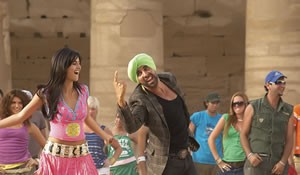
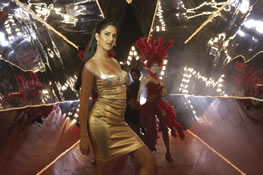
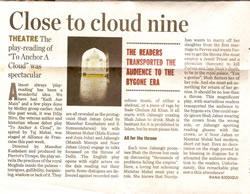

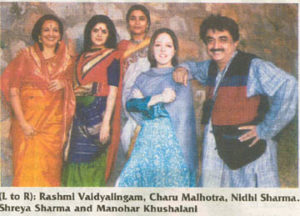
![kaa15[1]](https://stagebuzz.in/wp-content/uploads/2016/03/kaa151-300x206.jpg)
